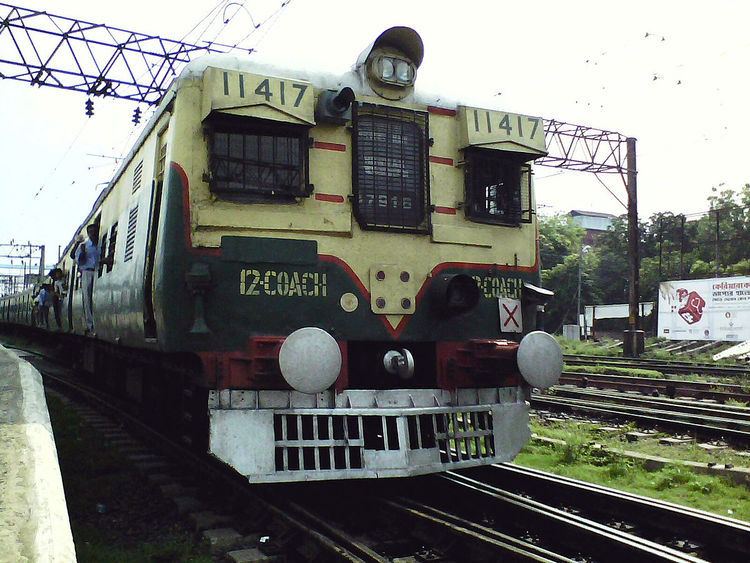System Commuter rail Locale West Bengal Opened 1854 Owner Indian Railways | Status Operational Stations 31 Operator(s) Eastern Railway | |
 | ||
Terminis Barddhaman Junction railway station, Howrah Junction railway station | ||
The Howrah–Bardhaman main line is a broad-gauge railway line connecting Howrah and Bardhaman via Bandel. The 108 kilometres (67 mi) railway line operates in Howrah, Hooghly and Bardhaman districts in the Indian state of West Bengal. It is part of the Howrah–Delhi main line and the Kolkata Suburban Railway system.
Contents
History
The East Indian Railway Company which was formed on 1 June 1845, planned to construct a line from Howrah to Delhi. After surveys, construction began in 1851.
Howrah station was a tin shed and to reach it from Kolkata one had to cross the Hooghly in a ferry. On 15 August 1854, the first passenger train in the eastern section was operated up to Hooghly, 39 kilometres (24 mi) away. On 1 February 1855 the first train ran from Howrah to Raniganj, 195 kilometres (121 mi) from Howrah.
Access to Howrah Station
A pontoon bridge was built across the Hooghly River in 1874 to provide easy access to Howrah Station, and in 1943 the cantilever Howrah Bridge, later renamed Rabindra Setu, was built.
Other routes
The Sheoraphuli-Tarakeswar Branch Line was constructed in 1885, and the Howrah–Bardhaman chord, a shorter link to Bardhaman, was constructed in 1917. (See route diagram for Sheoraphuli-Tarakeswar Line with this page also).
With the construction of the Jubilee Bridge in 1887 across the Hooghly, railway lines on the eastern side of the Hooghly were linked to the Main line at Bandel. In 1932, the Calcutta chord line was built over the Willingdon Bridge joining Dum Dum with Dankuni.
In 1913, the Hooghly–Katwa Railway constructed a line from Bandel to Katwa, and the Barharwa–Azimganj–Katwa Railway constructed the Barharwa-Azimganj-Katwa Loop Line.(See route diagram for the Bandel-Katwa Line with this page).
The railway track was extended to Belur Math in 2003.
Electrification
Electrification of the Howrah–Bardhaman main line was initiated up to Bandel in 1957, with the 3000 v DC system, and the entire Howrah–Bardhaman route completed with AC system, along with conversion of earlier DC portions to 25 kV AC, in 1958.
Tracks
There are 5 tracks between Howrah and Belur. There are 3 tracks between Belur and Bandel, 2 tracks between Bandel and Saktigarh, and 4 tracks between Shaktigarh and Khana.
Loco and car sheds
Howrah has a diesel and an electric loco shed. The diesel loco shed houses WDM-2, WDM-3A, WDS-6 locos. The electric loco shed houses WAP-4 loco. Commissioned in 2001, it is one of the largest WAP-4 sheds in Indian Railways. It has facilities for stabling 70+ loos. There is a diesel loco shed at Bamangachi with WDM-2, WDS-4 and WDS-6. Bardhaman has a diesel loco shed with WDG-3A, WDM-6, WDM-2 and WDM-3A locos. There is a diesel loco shed at Liliuah and a EMU car shed at Howrah and Bandel. Liluah Carriage & Wagon Workshop maintains coaches and freight wagons.
Tikiapara Coaching Depot maintains 22 primary base trains and 6 round trip trains. Total coach holding capacity is 744 coaches. It handles prestigious trains like Rajdhani Express and Duronto Exptress. The Coaching Depot is under Howrah Division, Eastern Railway. Bardhaman Coaching & Wagon Depot can maintain four passenger trains, including one DEMU rake. It has a capacity of holding 71 coaches.
Speed limits
The Howrah–Bardhaman main line is classified as ‘B’ class line where trains can run up to 130 km per hour .
